2323 BC. - c.2134 BC.
and
The First Intermediate Period
Dynasties 9-11 c. 2134 - 1991 B.C.
by Ottar Vendel
2323 - 2150 BC (173-181 years)
and Netjerkare and Menkare from dynasty seven
might possibly belong to this 6th dynasty.
Manetho ends with queen Nitokris
and the dynasty saw four
pyramids.
| Name | Manetho | Reign | Manetho | Pyramid | |
| 1 | Teti | Othones | 32 | 30 | Sakkara North |
| - | Userkare | - | 3? | - | ? |
| 2 | Pepi I | Phios | 34 | 55 | Sakkara South |
| 3 | Merenre | Methosophis | 9 | 7 | Sakkara South |
| 4 | Pepi II | Phiops | 94 | 94 | Sakkara South |
| - | Merenre II? | - | 1,1? | - | ? |
| - | Name lost | - | - | - | - |
| 5 | Nitokris | Nitrokis | 2-4 | 12 | ? |
| Years = | 169 | 198 |
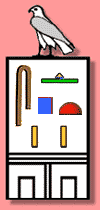 |
We know that he started quarry work in Upper Egypt, and that he maintained commercial and diplomatic relations with the trade center of Byblos in Syria, valuable for import of timber. He also may have initiated expeditions like his predecessors, towards the land Punt and Nubia. As for the latter he is attes-ted for as far south as the town of Tomas.
At a temple at Abydos we can read about his generous ex- empting from taxes, probably after a bad season of agriculture
There is only one statue found of him, found by his tomb. He is portrayed as a middle aged man with fleshy cheeks and big piercing eyes.
The historian Manetho states that Teti ended his life in a very unusual way for a pharaoh - he was murdered. The men behind the possible asassination are not mentioned, but an assumption is that the next king to be, who was of obscure origin, might have had something to do with his death. No evidence is present today (2002) though to confirm such a conspiratory theory.
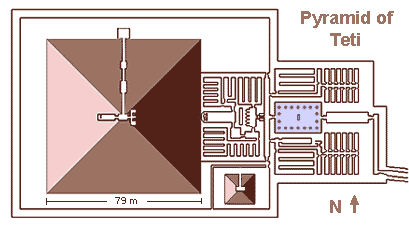 |
The pyramid complex of Teti was built in a traditional manner. The mortuary temple had no pylons and was roofed all over, except for the open big pillar hall in the centre (light-blue).
|
His pyramid was built at south Sakkara a couple of hundred meters northeast of Djoser's complex. It contains pyramid texts, written on the limestone-covered walls of the burial- and antechambers. This tradition was begun by his prede- cessor and followed by most pyramid builders after him. When the burial ch- amber was entered an unfinished decorated sarcophagus (now gone) was found and an arm and shoulder of a mummy, presumed to be the king's, was found on the floor. This looks like a grave robbery executed in haste.
The valley temple and causeway are located to the southeast and have not been properly investigated. Outside the main complex are small pyramids of his con- sorts and tombs of his two viziers Mereruka and Kagemni known for their well preserved tombs with many fancy reliefs and paintings.
Modern Egyptians call for some reason Teti's monument "The Prison Pyramid" and name in hieroglyphs was a pillar of strength (Djed), three thrones and a pyramid (picture below)
About 90 meters north of Teti's complex are situated two small pyramids (c. 20 x 20 x 20 meters) from his first queen Iput (I) and another of his favorites called Khuit. Their remains were discovered in the beginning of the 20th century and no valley temples, cult pyramids or causeways seems to have been built. In 2008 investigations started at the site and hopefully new information on these tombs will come to light.
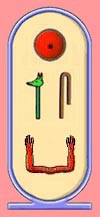 |
Userkare may have been a surviving claimer for the throne from the fifth dynasty and a rival to Teti for accessing the kingship. Since Manetho tells that pharaoh Teti was killed by his bodyguards, theories of conspiracy have been put forward advocating that Userkare was the man behind, but after a short reign was put out of office by the murdered king's son Pepi, the next king to be. There is a very slight possibility that he (Userkare) became pharaoh for a while because the crown prince was too young and left office when the heir had reached a proper age to rule himself. But in that case he would hardly have cal-led himself "king", as he did.
No monuments of Userkare's have bee found and remains of his tomb (pyramid?) are possibly yet to be found. This lack of substantial remains is the backbone in the theory that he was a usurper who was overthrown from the leadership and thus his remains have all been deliberately destroyed or taken over by the fol-lowing kings. Future finds will hopefully bring knowledge about Userkare's deeds, who he really was and where he came from.
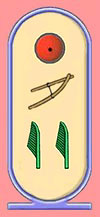 |
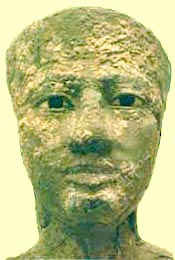 One of the names of Pepi I was "The Ka (soul) of Re is power- ful" (in picture left) and reflects back on the traditional solar cult from Heliopolis that was slowly loosing its grip as the most imp- ortant manifestation of the diver- ted religion of Egypt.
One of the names of Pepi I was "The Ka (soul) of Re is power- ful" (in picture left) and reflects back on the traditional solar cult from Heliopolis that was slowly loosing its grip as the most imp- ortant manifestation of the diver- ted religion of Egypt.When he ascended the throne he had the name of his predecessor king Userkare removed wherever possible, indicating a feud in the royal family.
Many building projects of his are known from Bubastis in the delta to Aswan in the south, but little of it remains. Some of it was possibly incorporated into later projects made by other rulers, but he did leave behind many inscriptions from his time telling about his deeds during his three decade reign.
He organized expeditions to Sinai and Nubia and has left rock carving in Wadi Hammamat, a 120 km long path between the Nile valley and the Red Sea.
One most remarkable find from this king was made in Hierakonpolis in Upper Egypt. It was a large copper statue of him and his little son Merenre, which is unique in Egyptian history. The head in the picture above in from this piece of art.
He built his pyramid complex at south Sakkara four kilometers south of Djoser's complex and a couple of hundred metres from the pyramid of fifth dynasty king Djedkare Isesi. During the 19th dynasty it was restored and text from this occasion tells that it was in good condition at that time, though it by then had been standing for almost a millenium.
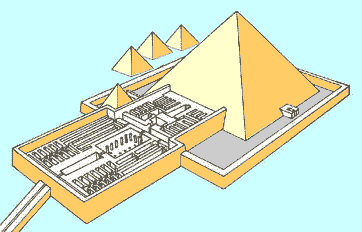 |
The pyramid complex of Pepi I as seen from northeast. The entrance to the pyramid was by the mini chapel and the mortuary temple had no pylons flanking its entrance.
|
When early Egyptologists entered the subterranean rooms from the north side entrance in the late 1800s, they found pyramid texts incised in the walls, spreading light over the builder of the monument and more. The valley temple and causeway are still to be investigated, but the remains of them seem to be very few. The mortuary complex was almost a duplicate of Teti's and the pyramid was of six dynasty standard size: a 79 m square with a height of 53. It also had a name of its own: "The Established and Beautiful Pyramid" (picture below).
Today this beauty is a twelve-meter high ruin.
In a single papyrus document an officer tells about his participation in the king's five campaigns into Palestine reaching as far as up to mount Carmel. These military actions were made both on land trough infantry and cavalry, and by the Egyptian navy at sea.
(Nemtyemsaf I)
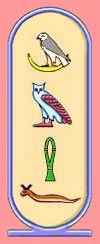 |
His personal name within a cartouche right is Nemtymsaf meaning "Nemty is his protection" and his Horus name Ankh- khaw "Horus living of apparitions" is in the serek left.
 |
It looks like during his reign the society "apparatus" followed in the old scheme of protecting the country from foreigners and consolidating the inner strength, stability and economic wealth.
His pyramid complex was built at the old south Sakkara burial ground, and it app- ears not to have been fully completed, pro- bably due to his premature death.
Today it's hardly noticeable but in the late 1800s the mortuary temple, 250 m pathway and enclosure wall of mud brick were still visible. The valley temple has not been mentioned yet and the whole area has never been extensively investigated.
The events during his reign that are attested for are the campaigns to Nubia and further south. The goods were wood for constructions and also soldiers for hiring into the army. The Egyptian governor of Aswan has written in his tomb that he was responsible for four expeditions during Merenre's reign and his brother's.
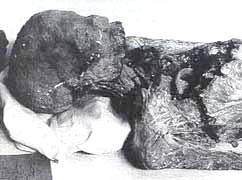 |
A modern test would perhaps give a final answer, if the mummy is still available in the Egyptian Museum. |
The relationships within the royal family were more complicated than usual during Merenre's time and his younger half brother (the Pepi II to be) was also his cousin, stepson and son-in-law(!). This plus the fact that several persons wore the same names makes it tricky to make a table to make a grip of the royal family structure.
A most valuable find of his is and totally unique for Egypt and the Middle East region as well, is a copper statue found at Hierakonpolis in Upper Egypt.
Other remains from his time are:
1) A small sphinx of him in the National Museum of Scotland, Edinburgh.
2) A box made of hippopotamus ivory in the Louvre Museum in Paris France.
3) An inscriptions on ivory found at his pyramid temple at Giza.
4) Notes in biographies from owners of private tombs in Abydos (2 notations), Elephantine, Deir el-Gabrawi, Edfu and Sakkara.
His name has also been found in rocks carvings in the Wadi Hammamat path between the Nile Valley and the Red Sea, and in alabaster quarries.
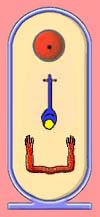 |
He had a number of queens, most of them related to him, and one of his sons, Merenre II, who may have succeeded him, perhaps for only one year.
His throne name in cartouche right holds the hieroglyphs Nefer-Ka-Re (Beautiful is the soul of Re) which was the most common combination among all phataohs over the years.
His pyramid and mortuary complex was built at South Sakkara and the pyramid's name was "The Established and Living Pyramid" (picture at bottom left).
It was built and decorated in a much poorer manner then his predecessors and power and wealth of high officials spread all over Egypt dragging control away from the capital Memphis. Administration of the country became difficult and he appointed one vizier each for Upper Egypt and Lower Egypt to regain control, but in vain.
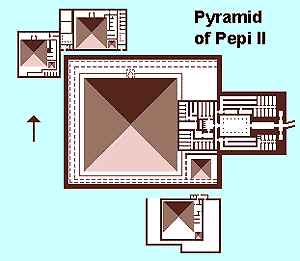 |
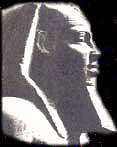 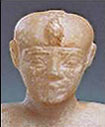 |
Except for finds at his burial ground the mayor remains of Pepy II are:
1) A statuette made of calcite with the young king sitting on his mother's lap.
2) A stone head found in a shrine at Koptos can possibly be a depiction of him.
3) A big (58 cm) brown stone relief fragment with his name, found at Koptos.
4) Five written decrees found at Giza, Abydos, Koptos (3) plus another (now
in the Egyptian Museum in Cairo) recording one of his many Sed festivals.
5) Inscription found in the mortuary temple of Ipwet II, Merenre I's daughter.
6) The king mentioned in tombs of Djau at Abydos and Ibi at Deir el-Gabrawi.
7) Smaller items like - a calcite vessel, faience plaques, an ivory headrest with
his name and titles written on it and various objects found at Byblos in Syria.
8) A small shrine at Abydos may have been a Ka-chapel built during his reign.
(Nemtyemsaf II)

Merenre Djefaemsaf
The sixth dynasty was coming to an end in many ways, and civil disorder and lack of central power speeded up this process.
Pharaoh Merenre Nemtyemsaf II (whose whole nomen and prenomen "Merenre Djefaemsaf" is seen in the cartouche above) had not reign but a year when he was murdered, and this is quite unique in Egyptian history despite several periods of decline and civil war.
Both the historian and the Royal Canon of Turin agree on the facts that his reign was little over a year, not long enough to leave any material remains. Thus we do not know where his tomb is, nor do science have any depictions in any form to tell what he looked like.
This lack of information can be partly compensated by his better known and more written about sister/widow Nitokris below which contains a history told by a Greek historian how he ended his days by being murdered.

Nitekreti
Romantic myths have been told in later times about Queen Nitokris (in Egyptian: Neitkrety or Nitokerti) but little to nothing can be confirmed through old records.
Historical facts clearly state her name as a female pharaoh, one of three in the Egyptian 3000-year history - one in every millennium.
The Turin Papyrus places her (as seen in the cartouche above as Nitekreti) after Pepi II and possibly Merenre II and an unknown pharaoh towards the end of the 6th dynasty. She has gone to history in a romanticized way due to tales told by Greek historians. Manetho writes that she succeeded her brother on the throne after that he had been slain. Herodotos states that she took revenge on the murd-erers by inviting them to a banquet in a basement hall in her temple and then let in the water from the Nile by a secret huge pipeline and drowned them like rats!
After this she ran in to a room full with embers and fried herself to death rather than meet the vengeance of the others from the murder conspiracy.
 |
The brother of hers who was assassinated and whom she succeeded could have been Merenre II who must have had a very brief reign.
She cannot be identified by remains from any historical records but there are a few inscriptions indicating that a pharaoh by the name of Neterkare (cartouche left from the Abydos king list #40) may have ruled during the dusky period at the end of the sixth dynasty. The names are rather alike sounding and there's a probability that it's the same ruler, but far from sure, and this triggered egyptologists to go further into the matter.
In the year 2000 the Danish Egyptologist Kim Ryholt thus put forward questions about the identity of Nitokris and a possible error made in the Canon of Turin.
A general standpoint since then is that the notation in the Turin Canon is instead a similar name of another obscure king by the name Neitiqerty (Neterkare) Siptah. Most probably, he is the ruler behind the catrouches in the king lists as he app- ears in the same place (alone) in the Abydos list of kings. His name is seen within a cartouche above left, and nothing more from him remains.
Where to put Nitokris instead is now anybody's guess, and maybee she's just a ro- mantic fabrication by people to tell by the camp fire in the evenings. This tale was later taken as a description of real historical events by scholars like Manetho and has been carried on as such well into the 20th century.
2150 - 2134?
During this period chaos ruled the country and civil disorder split the nation into different centers of power. Thus the names of the pharaohs can be many since at times three of them had their reign simultaneously over unknown areas. The Turin Canon has few entries and notes this was 955 years after the unification by king Menes, a semi mythical event that likely happened around 3150 BC.
Manetho uses a metaphor to discribe the state in which Egypt was during this period: "70 kings ruled for 70 days". The Abydos list has 17 kings (see below) for dynasties 7-8. Other minor sources have given the names: Menkamin I-II, Nefer- kare V-VI,

 These two kings are the first to be mentioned in the Abydos list after the break down of dynasty 6. Manetho says that Nitokris (last pharaoh of dynasty six) built the "third pyramid" probably meaning at Giza confused by Menkaure of the fourth dynasty.
These two kings are the first to be mentioned in the Abydos list after the break down of dynasty 6. Manetho says that Nitokris (last pharaoh of dynasty six) built the "third pyramid" probably meaning at Giza confused by Menkaure of the fourth dynasty. It's possible that Nitokris' throne name was Men-ka-re. No physical evidence has been found of Neter-ka-re and the duration of his reign is not known.

 NEFERKARE II ("Beautiful is the Ka (soul) of Re") is from the Abydos list solely. The common name might be an entry for another better-known ruler. No remains from him have been found.
Neferkare NEBI ("The protector") was a son of King Pepi II. He is present in the Abydos list and twice mentioned in the tomb of his mother - queen Ankhesenpepi II. No remains from him have been found.
NEFERKARE II ("Beautiful is the Ka (soul) of Re") is from the Abydos list solely. The common name might be an entry for another better-known ruler. No remains from him have been found.
Neferkare NEBI ("The protector") was a son of King Pepi II. He is present in the Abydos list and twice mentioned in the tomb of his mother - queen Ankhesenpepi II. No remains from him have been found.

 from the Abydos list only comes king Djedkare SHEMU ("Permanent is Ka (soul) of Re) and his birth name Shemu (or Shemai) possibly "nomad", shown by the hieroglyph of a man with a stick over his shoulder.
from the Abydos list only comes king Djedkare SHEMU ("Permanent is Ka (soul) of Re) and his birth name Shemu (or Shemai) possibly "nomad", shown by the hieroglyph of a man with a stick over his shoulder. No contemporary remains from his reign has been found to verify king Neferkare KHENDU (meaning "stri- ding"), known only from the Abydos list too.

 MERENHOR has cartouche number forty-six on the wall in Abydos and doesn't have solar god Re in his throne name. His name (from the bottom in the cartouche left) is water waves, a mouth, a hoe and the old falcon god Hor (Horus).
SNEFERKA comes only from the Abydos list cartouche number 47. His name doesn't contain a god and can possibly be read: The beautiful Ka (soul). No remains have been found from these kings.
MERENHOR has cartouche number forty-six on the wall in Abydos and doesn't have solar god Re in his throne name. His name (from the bottom in the cartouche left) is water waves, a mouth, a hoe and the old falcon god Hor (Horus).
SNEFERKA comes only from the Abydos list cartouche number 47. His name doesn't contain a god and can possibly be read: The beautiful Ka (soul). No remains have been found from these kings.

 Abydos list number forty-eight notes the king NEKARE.
Abydos list number forty-eight notes the king NEKARE. He's a otherwise unknown ruler and no remains have been found from him anywhere in his supposed king- dom. Neferka TERERU is in position number forty-nine from the Abydos list. His personal name TERERU (or possibly Tererl), are the four hieroglyphs starting at the bottom and the meaning is possibly: "Respected by". Like his predecessor he has left no remains at all.
 This king ruled in the break between the seventh and eighth dynasty and he obviously praised the old falcon god Hor(us).
This king ruled in the break between the seventh and eighth dynasty and he obviously praised the old falcon god Hor(us). The parts tell that "the Ka (soul) of Horus is beautiful" instead of the solar god Re. Horus from the Upper Egypt was the older of the two and represented pharaoh himself but since dynasty four Re (as a sun disk) had been within the cartouches marking the king's title as "Son of Re". Neferkahor and a few other rulers of this period temporarily broke this tradition. No remains of his have been found.
2150 - 2134 BC ?
By this time Egypt had been divided into at least three parts. The capital Memphis had no longer power over Upper Egypt (Herakleopolis) and parts of the delta.
Aboute a dozen kings from Memphis are known, just by their names
at the Abydos list and have left no traces from their reigns. From
what's possibly dynasty 8 and onwards the Turin Canon has
two notations similar to the Abydos list. The color of
the numbers below indicate where the entry
comes from. The Abydos list only (blue
numbers) or from the Turin
Canon as well (black).
| 1 | 2 | 3 | 4 | 5 | 6 |
 |
 |
 |
 |
 |
 |
| Neferkare Pepisneb |
Sneferka- re Annu |
--- iw- kaure |
Nefer- kaure |
Nefer- kauhor |
Neferer- kare II |
 King Wadjkare (meaning: "Prosperous is the Soul of Re") is known from a written remain from his exemption decree with a cartouche containing his throne name. A very long birth name (Demedjibtawy) has by some scholars been considered his, and others claim that he (Wadjkare) actually was a king from dynasty ten or nine with the possible name Neferkare II.
King Wadjkare (meaning: "Prosperous is the Soul of Re") is known from a written remain from his exemption decree with a cartouche containing his throne name. A very long birth name (Demedjibtawy) has by some scholars been considered his, and others claim that he (Wadjkare) actually was a king from dynasty ten or nine with the possible name Neferkare II. His residence was probably located in the capital Memphis and he is one of few kings from this dusky era (dynasties 7-10) who has left archaeological remnants confirming his existence. His name (in the chartouche right) is taken from the Abydos King List.
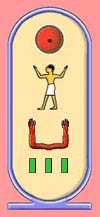
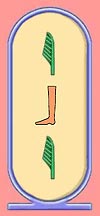 The ruler stands out from others during this period and is confirmed by the Turin Canon and the temple wall of Abydos, plus a quite substantial amount of graffiti in a remote place in Nubia called Tomas.
The ruler stands out from others during this period and is confirmed by the Turin Canon and the temple wall of Abydos, plus a quite substantial amount of graffiti in a remote place in Nubia called Tomas.Nothing about his deeds during his short reign (possibly just a few years) is known. His throne name as pharaoh: Qakare Ibi means, "Strong is the Soul of Re" (in the picture left) and his birth name was the shorter Ibi (picture right). He built a small pyramid located at South Sakkara, near the same type of monument from Pepi II. It was the last to be built on this classical burial ground (see its plan in the illustration below).
It was investigated already in the early 1800s by the German Egyptologist Lepsius who found it to be a true pyramid though it by then looked more like a mastaba in its ruined state. The identification of the builder has been made through reading hieroglyphic writings on the walls inside the grave chamber, the latest so called "pyramid texts" known. Today the inscriptions are protected by concrete con-structions within the monument, which is just a pile of rubble, three meters high.
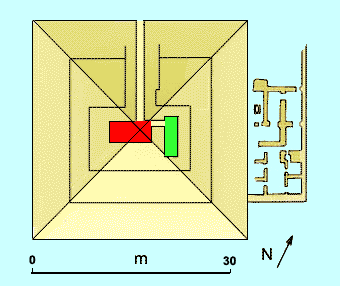 |
The pyramid of king Ibi is of a modest size compared to the monuments from the pyramid era. An entrance from the north side leads to the (red) burial chamber and the serdab - side chamber, (green). A small mortuary temple was built at the east side. |
The whole complex was not oriented in the cardinal directions (see picture above) and the mortuary temple was built of bricks and hardly more elaborated in size than a small chapel. No causeway has been detected leading from it and there possibly never was one, and the same goes for a valley temple.
The measures of the pyramid are roughly estimated but the sides are likely to have been 31,5 meters and the height of the building about 21 meters.
The First Intermediate Period
(FIP)
c. 2134 - 1970 B.C.
Little is known about these two dynasties
ruling simultaneously to dynasty 11.
Dynasties 9-10 from Herakleopolis in the north saw around 18 kings during almost a century and for a period the north seem to have control down to Abydos area just before Thebes conquered the whole country. Seven kings were called Khety it's the same name as Akhtoy in Greek: Achtoes. Beneath are the entries from the Turin Canon (damaged just there) and probably all kings are from Herakleopolis.
Neferkare Khety, ..., Senen..., Meribre?, Shed...y, H... Meribre, Khety (four kings), Neferkare Ankhtify, Kaneferre, Merikare, Neferkare Khety, Wahkare Khety, Meryhathor, Iytjenu.
The division into two dynasties is not from contemporary text, but added later.
Meribre Khety VII


Merikare has been known to the afterworld mainly for two reason:
1) He was the addressee of the famous moral/political instrucions from his father (above) whom he succeded, and
2) Contemporary texts say that he built a pyramid in Sakkara called "Places of Merikare enjoy prosperity" but its exact location is not known. He has been sug- gested as the owner of a pyramid also claimed by some Egyptologists to be a monument built by king Menkauhor from the fifth dynasty (see him). It is quite ruined and called "The headless pyramid" and is now (year 2008) investigated for the at least the forth time in an attempt to establish its true owner.
Closing this period is a mysterious king from Middle Egypt by the name:
An obscure ruler with a big monument
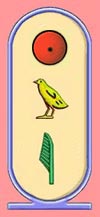 |
It was probably intended to be a pyramid or mastaba of some sort, and it still stands clearly visible in its ruined state today.
The first notation of substance of it comes from a digging there in the early years of the 1900s, resulting in a short article in the Egyptian Museum magazine ASAE in 1912.
Some forty years later it was investigated again for two sea- sons (1946-1948) by the French archaeologists Raymond Weill who wrote about the digging in a 12 page article in the same publication in 1947. He concluded his work by an adding up in a thin book of around 130 pages in 1958, and regrettably just published in French.
The tomb is located on the western bank around 300 meters from the flood plain and the remains of the construction makes it unclear whether it was a pyramid or some kind of stepped mastaba, because the remnants of the mud brick walls have sloping sides and are built in steps. This has left the door open for ideas about what it once could have looked like and thus it has generated some more or less plausible theories.
As expected opinions among Egyptologists are divided about its original (or inten- ded) design as wella as its age. The plan is slightly rectangular with the impres- sing measurements 146 by 136 meters, the far largest since tombs of mighty rulers from the Old Kingdom times.
It's also turned slightly counter clockwise from a north-south direction, just like many Old Kingdom tombs are. In addition a very exclusive detail was found when trying to determine its outer limits - the corners were heavily rounded (diameter: c. 23 m) and this is a very rare feature in ancient Egyptian architecture.
Today (year 2008) it's in a ruined state and it's difficult to say if it was dismantled after once being finished, or if it was finished at all, which it probably wasn't.
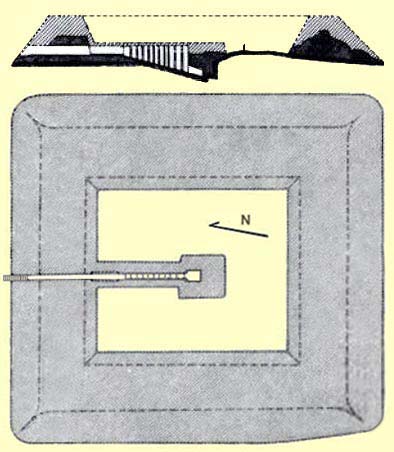
The simple design of the superstructure has a striking resemblance to those from the Old Kingdom mastabas, like the great one at Beit Khallaf (see link to this monument from the intro page) which was built during the reign of king Djoser in the third dynasty. Both monuments have straight sloping corridors from the north, built with a vaulted roof and ending directly to the grave chamber. They are both founded on the natural unworked gravel and do not reach down to the bedrock. The corridor of Khui is at first horizontal and open and then becomes a sloping tunnel supported by eleven transverse brick arches and ending at the burial chamber about nine meters below ground surface. The chamber is lined with roughly hewn limestone blocks, probably taken from dynasty six tombs nearby.
The room itself is very small (around 3,5 by 7 meters) and is totally empty and if there ever was a burial taken place here (or not) cannot be substantiated by any finds or observations on the site and elsewhere.
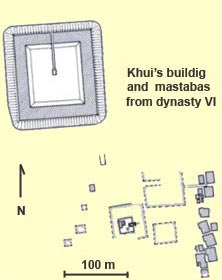 The outer walls were made of mud brick masonry and the sloping sides are still
visible and were possibly intended to be cased by stone or being smoothed with clay plaster.
The outer walls were made of mud brick masonry and the sloping sides are still
visible and were possibly intended to be cased by stone or being smoothed with clay plaster. The material making the core was just fil-ling of gravel and sand, held in place by the surrounding brickwork which has a thick- ness up to almost 40 meters (see pictures). This "budget" way of making his last resting place tells that the owner, despite the great size of his tomb project, was a ruler of lim-ited means and power.
What seems to have been a mortuary tem- ple has also been detected on the north side facing the Nile, but its general plan can't be determined. The remains found was a part of a massive mud brick outer wall with a length of about 35 meters which today is bu- ried under the houses of a modern village.
What makes Khui the supposed builder is a single inscription on a block of stone which possibly once was a part of the building itself or placed within the area.
It was found nearby to the south and has an offering scene in relief carved into it and his name written within a cartouche to mark that he was a pharaoh. This is the only evidence telling that a ruler bearing this name has ever existed. Thus it's not possible to settle which dynasty he belonged to (if any), but for practically rea- sons he is mostly put into dynasty 10.
Khui may have been a local ruler despite his depiction of himself as the king of Egypt. The site he choose for his tomb is located midway between the two main political centers at the time - Herakleopolis in the north (near the Faiyum) and Thebes in the south, possibly making some local independence here during peri- ods when the central power was weak and the country divided.
A strong possibility, not to say a likely explanation, is that Khui's building origi-nally was an unfinished Old Kingdom monument, which has been taken over by local leaders during history. An examination using modern methods might give results complementing those from the 1940s and dates from more than one period are not excluded but rather to be expected.
c. 2134 - 1991 B.C. (c. 143 years)
Some charts put this dynasty into the Middle Kingdom and most have six rulers starting with Antef I. The kings called Mentuhotep can be three or four depending on which one is concidered the first "real" pharaoh. Their throne names is the best way for an identification. After 85 years of ruling just the area of Thebes, a king from there started a war and reunited Egypt after 15 years of struggle. The lifestyle and local gods of the south were then introduced to the whole country.
"Prince of the South"
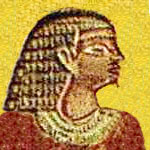 Prince Antef |
He must have lived around 2130 B.C. and is mentioned as predecessor of Mentuhotep (I) from the "Hall of an- cestors" in the Karnak temple from the 18th dynasty built by Thotmes III. He is there given the unusual title: "Count and Hereditary Prince." A stele from Drab Abu Naga calls him: "the Hereditary Price, Count of the Great Lord of the Theban Nome - Antef." A stele from Dendera describes him in a similar way as: "The Great Prince of the South - Antef". Possibly he was related to the old royal family as he was given a prince-title, but the origin of his parents are unknown and a remark- able fact is that just his father's name is mentioned (several times) and not his mother's from whom he (if so) had inherited his title. There are no records telling if the following pharaohs were descendents of his, but since three of them were called Antef it may be the case.
Chief of Thebes
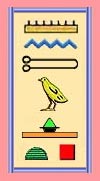 Mentuhotep |
It is not known who his father was, but it might be the Antef mentioned above. No contemporary remains tell that he ever claimed to be pharaoh over Egypt and his name has not been found written within sereks or cartouches from his own time. His son and follower on the other hand (below) called himself "King over the Two Lands", which was a fine title though not entirely correct. The Canon of Turin has for the 11th dynasty a row (first of six) where the name is lacking and this might indicate that he was at his point in history considered a king and had a throne name of his own, which now is lost. Whether he was the first "real" pharaoh named Mentuhotep is therefor just a question of taste. By the total years given for the whole dynasty (just six rulers in the canon) his reign is estimated to have been around seven years. The place of his tomb has not been located, but may be found in the mountain side of Western Thebes, where the other coming six rulers of the dynasty are buried.
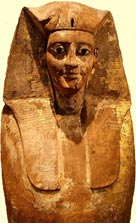
 King Antef I was the founder of the 11th Dynasty and son of the local tribe chief of Thebes - Mentuhotep (above).
King Antef I was the founder of the 11th Dynasty and son of the local tribe chief of Thebes - Mentuhotep (above).His Horus name Sehertawy (within a serek right) had the meaning: "The one who makes the Two Lands satis- fied". When he entered office the two lands were divided and he set the task to reunite them and make the Nile Valley a prosperous land once again after a couple of decades of anarchy and chaos in the administration and finances. History tells he made a good job, and one of his offsprings finally succeeded a century later.
He started to subdue the towns in the neighborhood such as Hierakonpolis and el-Kab to the south and Nagada, Koptos and Dendera to the north. The land further downstream (north) was held by the kings of Herakleopolis, a town by the border of the Faiyum basin in a distance of 600 km from Thebes.
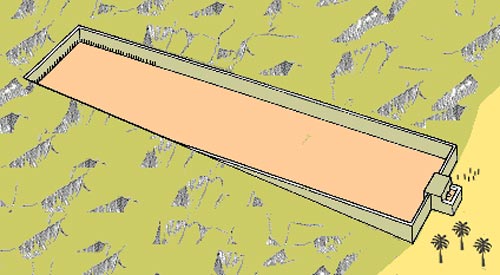 |
The "Saff tomb" made by the Antefs I-III and the last kings of dynasty 11.
A courtyard was cut into the hillside ending with several tombs for the royal family hewn in to the bedrock. The length varied from 75 to 150 metres. Remains indicate that a small pyramid might have been placed in the yard. |
During his reign of about 16 years of civil war (though with separated areas and a visible front/border) Antef didn't manage to extend his small kingdom further and this was the task and challenge he left for his son and successor. Since this son of his had a reign of almost half a century, it's quite likely that Antef I died rather young, hardly reaching his middle age.
He (and the two Antefs to come) was buried in a long, narrow rock cut tomb a so called saff-tomb or row tomb (picture above). They were placed at the west bank of Thebes at today's Dra Abu el-Naga 3 km east of Deir el-Bahri. The design was unique with no known forerunner as prototype. It consisted of a big open "row" or courtyard going in to the mountain side where it ended with several chambers cut in to the sides.
They were probably made for the king's closest family members like consorts, sisters, brothers, sisters in law etc. A notable fact is that the king's tomb (burial chamber) was not significantly bigger than the others. A question is if the small pyramids placed within the yards (indications tell of such buildings) could have been the final resting places for the kings, but this is just a theory.
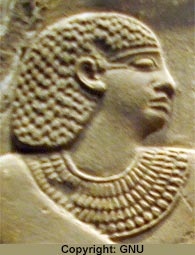
 Antef II was the second king of the 11th dynasty and his Horus name Wah-ankh (in the serek right) means "Strong in life".
Antef II was the second king of the 11th dynasty and his Horus name Wah-ankh (in the serek right) means "Strong in life".His mother was a certain Neferu, and his reign was, according to the Turin king list, 49 years long and dur- ing this period he manage to consolidate his territory to a great extent.
The rulers of the contempo- rary 9th and 10th dynasties in middle and northern Egypt were joining forces and tried to take back the territory they had lost previously to Antef I, and started to moved south towards Theban dominated areas.
Antef II, who was ruling the 7 provinces in the south of the country, struck back, and the front was moving many times from north to south before he finally manage to drive his oponents as far north as a good stretch of valley north of Abydos up to the 13th province right at today's Asyut. By doing so half of Upper Egypt was in his hands, and the rest of his reign was peaceful. In the south he broke through to the first cataract at Aswan early in his reign. By this he regained Egypt's traditional southern border to the south and built a temple to the goddess Satet on the island Elephantine at the very same location.
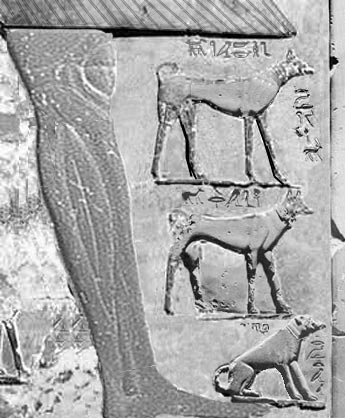
After his earthly deeds he was put to rest in a rock cut tomb next to his predecessor's in the Theban necropolis.
In his mortuary chapel was retrieved a magni- ficent limestone stele with high reliefs of the king's favorite dogs (picture left), standing by their master.
Curiously this fine work of art was known to Egyptologist before it was found, because it had been written about in other records from the twentieth dynasty a thousand years after it was made.
A necropolis inspector had come across it and considered it s very re- markable old work of art worth reporting to his chief about, and so he did which was a lucky strike for Egyptology.
Two of the dogs can be identified by the hieroglyphs beside them telling their Libyan names with the Egyptian translation at the side. The one in the middle probably had a name common for the two languages.
From the top they are:
1) BEHEKAY (Egyptian: Mahedj) meaning "gazelle".
2) ABAQER (no translation) meaning "greyhound", probably in both languages.
3) PEHETEZ (Egyptian: Kemu) meaning "Blackie".
The last name has the same root for "black" (kem) as
These three dogs (slightly adjusted in the picture) are probably the oldest in human history known by their names. Notable is the artist’s practical aim to get a straight vertical right end to his work, and this was achieved by ordering Blackie to sit down on his master's foot!
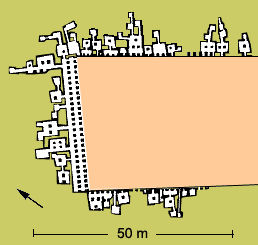 |
The inner part of the saff tomb complex of Antef II with a total length of c. 150 meters. From the open court ("row") about twenty tombs were made in the bedrock for the royalties (and the king?). They were all of modest size as was the one of the king himself (someone left of the double row of columns?). An elaborated form of this tomb design was later to be the big temple of Mentuhotep at Deir el Bahri (see below). |
 Antef III was the third king of the 11th Dynasty and very little is known about what happened in the country during his brief reign of around eight years. He is thereby the one less known about of the three Antefs.
Antef III was the third king of the 11th Dynasty and very little is known about what happened in the country during his brief reign of around eight years. He is thereby the one less known about of the three Antefs.His long Horus name Nekhet-neb-tep-nefer (shown within a serek at picture right) has the humble meaning: "Horus, The Victorious One, Lord Of The Good Beginning".
The Royal canon of Turin gives him a reign of at least eight years, though his name is lacking but fragment of a title is visible at the row. It seems that during his reign a sort of status quo was at hand in the country, because he did not gain nor lose any territory to his northern enemies in the civil war, the kings of the 9-10 dynasties from Herakleopolis.
He was probably buried in a narrow rock cut saff-tomb at Western Thebes next to Antef II, 3 km east of Deir el-Bahri, the site where his famous son and successor built himself a famous mortuary complex. No proof has been found at the site to clearly identify the tomb as his and the only real archaeo- logical evidence from him, is a door jamb with his name within a royal cartouche found at Abydos.
He made his most resolute contribution to Egyptian history in cooperation with a woman named Iah. Whether she was his first queen, a secondary consort or had another status, we don't know. Anyhow - they produced the next king to be, Mentuhotep II (below), one of the most distinguished kings ever in the Nile Valley.
 Mentuhotep |
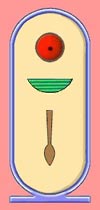 Neb-hetep-Re |
Mentuhotep then took action and moved downstream (north- bound) with his army and managed to reach middle Egypt.
After a good 30 years on the throne he manage to conquer the enemies' capital and became the sole ruler from the southern Nubia to the Medi- terranean Sea. He was thereby the first pharaoh from Thebes who could rightfully adopt the fancy title "King of the Two Countries".
To consolidate his nation he followed up his victory by campaigns along the coast in both directions crushing the fleeing part of the Egyptian opposition and weak-ening disturbing tribes in Libya and southern Palestine.
He lived for another twenty years and left a restored, rebuilt and wealthy nation, and this was the foundation upon which the next glorious period in Egyptian history - The Middle Kingdom - was to be built.
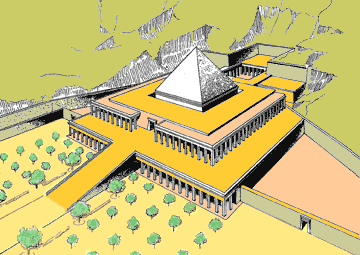
 |
Reconstruction of the mortuary temple of Mentuhotep at Deir el Bahari in West Thebes. His tomb was cut deep into the bedrock behind and underneath the building. Right: an over life size painted sandstone statue (2,52 m) of the king from the Metropolitan Museum of Art in New York.
|
Even during the re-conquest of Egypt, Mentuhotep had built or restored several monuments in Upper Egypt like those of Dendera, Abydos, el Kab and Elephan- tine at Aswan. He paid special homage to Thebes's war-god Mentu, who had helped him to accomplish his task, by adopting his name and build temples to him at Medamud, Armant and Tod.
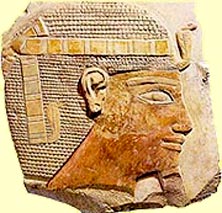 |
| Relief of the king found in his mortuary temple. |
On top was erected a symbolic burial mound of massive stone, probably in form of a pyramid or a mastaba. The real tomb with the king's burial chamber was cut into the rock behind and underneath the temple in a way that would be the proto-type for royal tombs in the future.
At the ground level sycamore trees were planted on both sides of the entrance stairway in a regular pattern, and the remains of the holes with fertile soil in which they were standing, is clearly visible today.
Unfortunately we don't know the name of the architect of this complex, but he surely must have been a man of fantasy and imagination. It's quite possible that Mentuhotep himself was partly responsible for the design, as the genius he was in organizing official projects and administrating the country.
Of all pharaohs during the long history of Egypt, he surely place among greatest with his outstanding character and personality.
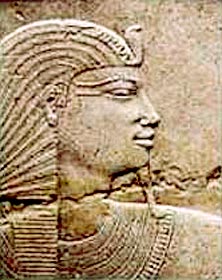 A young looking selfconfident king shown in a stone relief. |
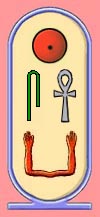 Sa-ankh-ka-re |
The depiction to the left is of a stone relief found at Armant, and depicts him looking like a young, strong and capable ruler. The inner stability was solid and he could finish all monu-ments initiated by his father, and send an expedition of 3,000 men to the land of Punt, going the route from Koptos through the mountains to the Red Sea. This shows that he had control of the finances and could afford such a task, which was a proof of national wealth and a tradition among those pharaohs capable of making a surplus from an smooth working taxation system.
Architecture and works of art were characterized by innovation during his reign and the reliefs are known to have a quality not to be seen even during the Middle Kingdom to come. At Medinet Habu he built a triple sanctuary for triads of gods. At the "Thoth Hill" nearby he erected a small temple to the god Thoth (see picture below) on the ground where a sanctuary from the first dynasty once had stood. In its quite remote location it wasn't found until 1904. The crude quality complex is made of mud brick and had once an entry with pylons and surrounding walls.
He began building his tomb near his father's monument at Deir el Bahri, but it was unfinished when he died. It consists of a causeway and a sloping passage ending a bit into the bedrock. Graffiti inscriptions in the vicinity indicate that his last resting place still might be to be found nearby.
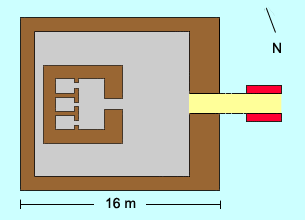
|
A reconstruction of the plan of Mentuhotep III:s very small Thoth temple (or rather a chapel) in Western Thebes. The entrance (yellow) with the pylons (red) and an open courtyard (gray) with a small sanctuary. It was recognized as late as in the beginning of the 1900s, probably due to its unusual location in a lofty position in the mountains overlooking the traditional burial ground in the valley. |
Considering the rather short time king Mentuhotep III had on the throne he must have been a very ambitious ruler with monuments built all over the country, and some of them were no doubt initiated by his predecessor, his father.
In one of the few depictions of him (a relief from Armant in picture above) he is depicted as a young man wearing the traditional head-dress - the nemes, a striped cloth which was worn exclusively by kings. In another depiction of him (through menu left) he i wearing the red crown of Lower Egypt.
His throne name (within the cartouche at top right) means "The One Who Feeds The Ka Of Re".
In the late 1990s was made an archaeology discovery which might solve the pro-blem about where he was buried. A tomb which likely is his was found placed right below the peak of the hill upon which his small sanctuary stood atop.
The fact that his tomb wasn't finished, though it ought to be if efforts had been made, and the fact that very few depictions of him remain, and possibly never was to be, makes one think that he was a ruler not eager to put his person at front. He rather, it seems, at first hand saw to the results of his deeds and got satisfaction through all building projects he fulfilled all over the country.
This gives the impression that Mentuhotep III was a modest man of great wisdom.
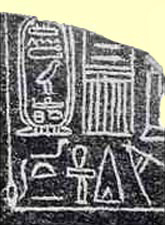 King Mentuhotep IV carved into a relief. |
His throne name (cartouche below) says: "He of the sedge and the bee" (symbols of Upper and Lower Egypt respectively). His reign only lasted about seven years and we know nothing of his age when he took office. For some reason he is missing in most king lists.
The Royal Canon of Turin has an empty row with seven missing years at the end of this dynasty where he possibly might fit in.
He may have been considered to be an usurper who had navigated to his position in a way not approved of by some of the ruling and upper classes. He had an opponent in a curtain Antef (possibly a member of the royal family) who adopted a royal title thereby perhaps stating that he was first in succession to the throne. Notable is that access to the highest office was inherited strictly through mothers of royal stock to prevent struggle among all offsprings of the pharaoh.
Another theory is that the early kings of the 12th Dynasty rewrote history to justify their claims to the throne since they clearly were not of royal stock.
During the second year of Mentuhotep's reign, he organized an expedition to the quarries between the Nile Valley and the Red Sea at the path of today's Wadi Hammamat 50 km down stream (north) of Thebes.
In this search for suitable material for buildings and his sarcophagus, texts say that during a rare occasion of a heavy rain storm a fine block of suitable stone was exposed.
 The King of Upper and Lower Egypt - Neb-tawy-Re |
Following the theory that he was historically erased after his death, the tomb of his would have been re- used with all visible tracks of him removed. A fact is that no depictions of him are known today and the only true testimony from his reign (since the official records seems to have vanished) are nearly twenty inscriptions with his name cut into the rocks by members of his mining expedition which was lead by his prime minister named Amenemhet. Most Egyptologists today agree on that this was the next pharaoh to be, a none-royal military leader and the founder of the next dynasty and era in Egyptian history - The Middle Kingdom.
If Mentuhotep IV was overthrown from his throne or ended his reign by natural causes we don't know, and in the latter case it's possible that he died without leaving an heir to succeed.
obscure rulers in the south
At the very end of the eleventh dynasty the central power of Thebes seems to have declined for a while, at least where the authority over the province of Nubia was concerned. In nine cities an otherwise unknown "king" made his presence known by recording his name on rocks. He had both a throne name - Kakare, and a personal nomen - Antef. Maybe he was heading for the throne in Thebes but he obviously did not reach that far.
Another ruler manifesting himself in Nubia was probably called Ibkhenetre and he only showed himself with a fancy cartouche (below).
A third chief is known during the same period and he was called Segerseni with the throne name Menkhkare. He is attested for only in rock inscriptions near the town of Umbarakab in Lower Nubia.
We don't know if these local chiefs ruled simultaneously or if they succeeded each other. Egyptologist von Beckerath advocates that their reigns were at the same time ruling different parts of Nubia.
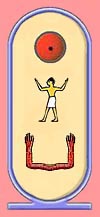
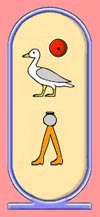
|
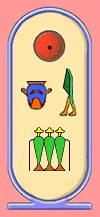 |
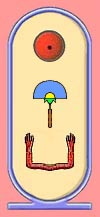 |
| Kakare Antef | Ibkhenetre | Menkhkare Segerseni |
Egypt had been at peace for 40 years.
The last ruler had a short reign
and a general took over
and founded:
The Middle Kingdom